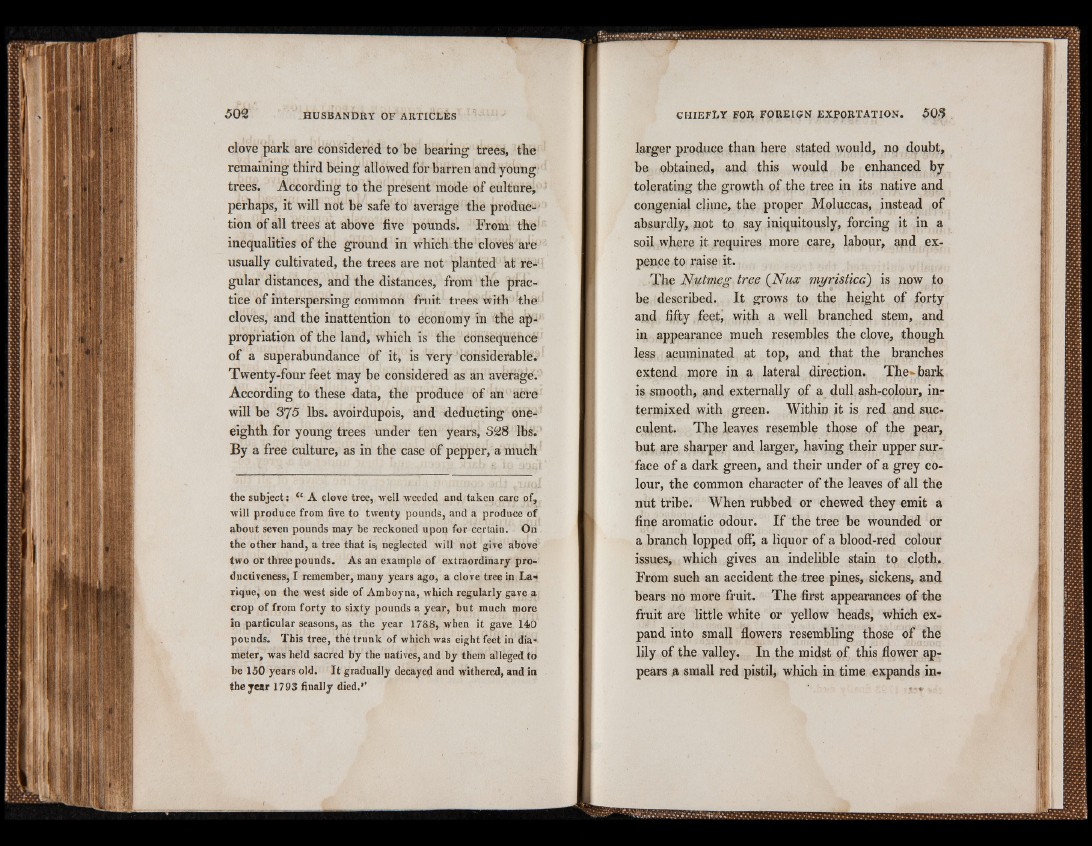
clove park are considered to be bearing trees, the
remaining third being allowed for barren and young
trees. According to the present mode of culture,
perhaps, it will not be safe to average the production
of all trees at above five pounds. From the
inequalities of the ground in which the cloves are
usually cultivated, the trees are not planted at regular
distances, and the distances, from the practice
of interspersing common fruit trees with the
cloves, and the inattention to economy in the appropriation
of the land, which is the consequence
of a superabundance of it, is very considerable.
Twenty-four feet may be considered as an average.
According to these data, the produce of an acre
will be 375 lbs. avoirdupois, and deducting one-
eighth for young trees under ten years, 328 lbs.
By a free culture, as in the case of pepper, a much
the subject: Ct A clove tree, well weeded and taken care of,
will produce from five to twenty pounds, and a produce of
about seven pounds may be reckoned upon for certain. On
the other hand, a tree that is, neglected will not give above
two or three pounds. As an example of extraordinary productiveness,
I remember, many years ago, a clove tree in La-
rique, on the west side of Amboyna, which regularly gave a
crop of from forty to sixty pounds a year, but much more
in particular seasons, as the year 1788, when it gave 140
pounds. This tree, thè trunk Of which was eight feet in dia*
meter, was held sacred by the natives, and by them alleged to
be 150 years old. I t gradually decayed and withered, and in
the year 1793 finally died.1'
larger produce than here stated would, no doubt,
be obtained, and this would be enhanced by
tolerating the growth of the tre.e in its native and
congenial clime, the proper Moluccas, instead of
absurdly, not to say iniquitonsly, forcing it in a
soil where it requires more care, labour, and ex-
pence to raise it.
The Nutmeg tree (JNux myristicd) is now to
be described. It grows to the height of forty
and fifty feet, with a well branched stem, and
in appearance much resembles the clove, though
less acuminated at top, and that the branches
extend more in a lateral direction. The»* bark
is smooth, and externally of a dull ash-colour, intermixed
with green. Within it is red and succulent.
The leaves resemble those of the pear,
but aye sharper and larger, having their upper surface
of a dark green, and their under of a grey colour,
the common character of the leaves of all the
nut tribe. When rubbed or chewed they emit a
fine aromatic odour. If the tree be wounded or
a branch lopped off, a liquor of a blood-red colour
issues, which gives an indelible stain to cloth.
From such an accident the tree pines, sickens, and
bears no more fruit. The first appearances of the
fruit are little white or yellow heads, which expand
into small flowers resembling those of the
lily of the valley. In the midst of this flower appears
a small red pistil, which in time expands in